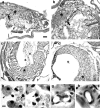Transient blockade of the CD11d/CD18 integrin reduces secondary damage after spinal cord injury, improving sensory, autonomic, and motor function
- PMID: 15102919
- PMCID: PMC6729422
- DOI: 10.1523/JNEUROSCI.5343-03.2004
Transient blockade of the CD11d/CD18 integrin reduces secondary damage after spinal cord injury, improving sensory, autonomic, and motor function
Abstract
The early inflammatory response to spinal cord injury (SCI) causes significant secondary damage. Strategies that nonselectively suppress inflammation have not improved outcomes after SCI, perhaps because inflammation has both adverse and beneficial effects after SCI. We have shown that the selective, time-limited action of a monoclonal antibody (mAb) to the CD11d subunit of the CD11d/CD18 integrin, delivered intravenously during the first 48 hr after SCI in rats, markedly decreases the infiltration of neutrophils and delays the entry of hematogenous monocyte-macrophages into the injured cord. We hypothesized that this targeted strategy would lead to neuroprotection and improved neurological outcomes. In this study the development of chronic pain was detected in rats by assessing mechanical allodynia on the trunk and hindpaws 2 weeks to 3 months after a clinically relevant clip-compression SCI at the twelfth thoracic segment. The anti-CD11d mAb treatment reduced this pain by half. Motor performance also improved as rats were able to plantar-place their hindpaws and use them for weight support instead of sweeping movements only. Improved cardiovascular outcome was shown after SCI at the fourth thoracic segment by significant decreases in autonomic dysreflexia. Locomotor performance was also improved. These functional changes correlated with significantly greater amounts and increased organization of myelin and neurofilament near the lesion. The improved neurological recovery after the specific reduction of early inflammation after SCI demonstrates that this selective strategy increases tissue at the injury site and improves its functional capacity. This early neuroprotective treatment would be an ideal foundation for building later cell-based therapies.
Figures







Similar articles
-
Timing and duration of anti-alpha4beta1 integrin treatment after spinal cord injury: effect on therapeutic efficacy.J Neurosurg Spine. 2009 Nov;11(5):575-87. doi: 10.3171/2009.6.SPINE08915. J Neurosurg Spine. 2009. PMID: 19929361
-
Methylprednisolone causes minimal improvement after spinal cord injury in rats, contrasting with benefits of an anti-integrin treatment.J Neurotrauma. 2005 Dec;22(12):1375-87. doi: 10.1089/neu.2005.22.1375. J Neurotrauma. 2005. PMID: 16379576
-
Anti-CD11d integrin antibody treatment restores normal serotonergic projections to the dorsal, intermediate, and ventral horns of the injured spinal cord.J Neurosci. 2005 Jan 19;25(3):637-47. doi: 10.1523/JNEUROSCI.3960-04.2005. J Neurosci. 2005. PMID: 15659600 Free PMC article.
-
Autonomic dysreflexia after spinal cord injury: central mechanisms and strategies for prevention.Prog Brain Res. 2006;152:245-63. doi: 10.1016/S0079-6123(05)52016-8. Prog Brain Res. 2006. PMID: 16198705 Review.
-
Latest approaches for the treatment of spasticity and autonomic dysreflexia in chronic spinal cord injury.Neurotherapeutics. 2011 Apr;8(2):274-82. doi: 10.1007/s13311-011-0025-5. Neurotherapeutics. 2011. PMID: 21384222 Free PMC article. Review.
Cited by
-
Treatment with an anti-CD11d integrin antibody reduces neuroinflammation and improves outcome in a rat model of repeated concussion.J Neuroinflammation. 2013 Feb 15;10:26. doi: 10.1186/1742-2094-10-26. J Neuroinflammation. 2013. PMID: 23414334 Free PMC article.
-
Anti-inflammatory treatments during the chronic phase of spinal cord injury improve locomotor function in adult mice.J Neurotrauma. 2011 Sep;28(9):1995-2002. doi: 10.1089/neu.2011.1888. Epub 2011 Sep 6. J Neurotrauma. 2011. PMID: 21740131 Free PMC article.
-
Viability-dependent promoting action of adult neural precursors in spinal cord injury.Mol Med. 2008 Sep-Oct;14(9-10):634-44. doi: 10.2119/2008-00077.Bottai. Mol Med. 2008. PMID: 18654659 Free PMC article.
-
Myeloid-Specific Blockade of Notch Signaling by RBP-J Knockout Attenuates Spinal Cord Injury Accompanied by Compromised Inflammation Response in Mice.Mol Neurobiol. 2015 Dec;52(3):1378-1390. doi: 10.1007/s12035-014-8934-z. Epub 2014 Oct 26. Mol Neurobiol. 2015. PMID: 25344316
-
Spinal Cord Injury Scarring and Inflammation: Therapies Targeting Glial and Inflammatory Responses.Neurotherapeutics. 2018 Jul;15(3):541-553. doi: 10.1007/s13311-018-0631-6. Neurotherapeutics. 2018. PMID: 29717413 Free PMC article. Review.
References
-
- Bao F, Chen Y, Dekaban G, Weaver LC (2004) Early anti-inflammatory treatment reduces lipid peroxidation and protein nitration after spinal cord injury in rats. J Neurochem 88: 1335-1344. - PubMed
-
- Barbeau H, Mccrea DA, O'Donovan MJ, Rossignol S, Grill WM, Lemay MA (1999) Tapping into spinal circuits to restore motor function. Brain Res Brain Res Rev 30: 27-51. - PubMed
-
- Basso DM, Beattie MS, Bresnahan JC (1995) A sensitive and reliable locomotor rating scale for open field testing in rats. J Neurotrauma 12: 1-21. - PubMed
-
- Bethea JR, Dietrich WD (2002) Targeting the host inflammatory response in traumatic spinal cord injury. Curr Opin Neurol 15: 355-360. - PubMed
-
- Bevilacqua MP (1993) Endothelial-leukocyte adhesion molecules. Annu Rev Immunol 11: 767-804. - PubMed
Publication types
MeSH terms
Substances
LinkOut - more resources
Full Text Sources
Other Literature Sources
Medical
